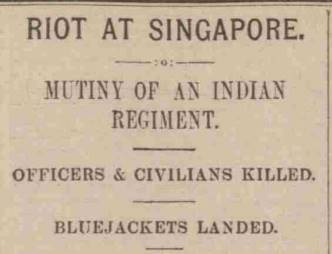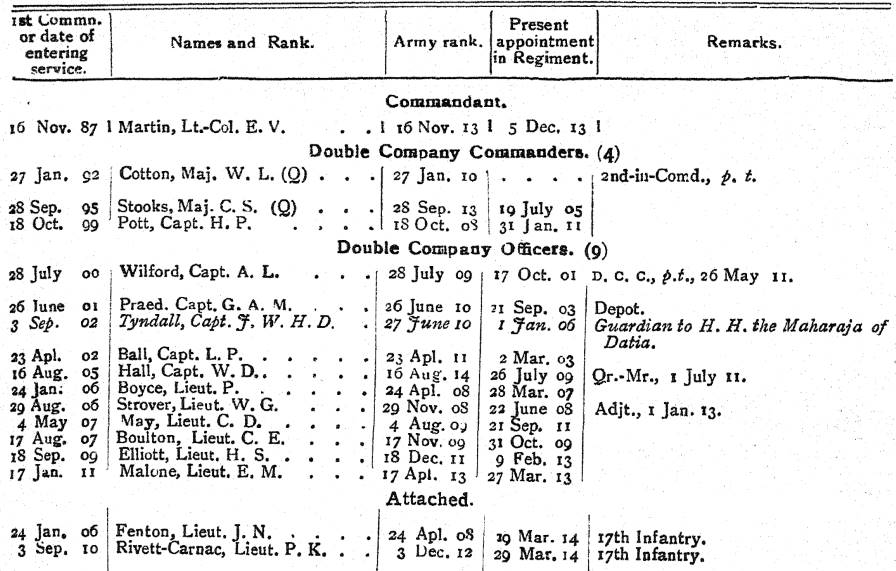This article is about the 5th Light Infantry and will help you to research the Regiment and the soldiers who served with it during the First World War. I have written a separate article for the 2nd Battalion 5th Light Infantry and a series of guides to help you to research soldiers who served in the Indian Army during the war. To view the guides click on the blue links below:
The 5th Light Infantry in the First World War
Lineage: Raised at Cawnpore in 1803 by Lieutenant J. M. Johnson as the 2nd Battalion, 21st Regiment, Bengal Native Infantry. In 1824 became the 42nd Regiment of Bengal Native (Light) Infantry and in 1842 the 42nd Regiment of Bengal Native (Light) Infantry. In 1861, the 5th Regiment of Bengal Native (Light) Infantry, then the 5th Regiment of Bengal (Light) Infantry in 1885 and in 1903 the 5th Light Infantry. The Regiment was disbanded on 12 January 1922.
Class Composition of Battalion in 1914: 8 Companies Muslims of the Eastern Punjab and Hindustan. 1919: 2 Companies of Muslims of the Eastern Punjab and Hindustan and 2 Companies of Ahirs.
Location in August 1914: The 5th Light Infantry was stationed at Singapore, Straits Settlements, having arrived on 5th April 1914, from Nowgong (Madhya Pradesh, India).
The 5th Light Infantry was an Indian infantry regiment which was stationed at Singapore when the First World War began in August 1914. The Regiment is now remembered for its mutiny which took place at Singapore on 15 February 1915. The causes of the mutiny are complex and there was no single issue which led to its cause. The mutiny was quelled within a couple of days with help from Russia and Japan but not before the mutineers had killed or wounded dozens of soldiers and civilians. In total, 201 Indian officers and men were court-martialled and convicted in the aftermath of the mutiny and 47 sentenced to death. There is a very interesting document held at the British Library in London which I have discussed in the further sources section of the page.
Newspaper header from the Newcastle Daily Journal, 24 February 1915 reporting the 5th Light Infantry’s Mutiny. The Singapore Mutiny was widely reported on in the British press.
British Officers of the 5th Light Infantry in the October 1914 Indian Army List. Of the officers recorded, Lieutenant Harold Seymour Elliott and Captain (then Lieutenant) Perceval Boyce were killed during the mutiny on 15 February 1915.
After its mutiny, the 5th Light Infantry was sent to Cameroon in West Africa where the Regiment served between August 1915 and early 1916. There is a complete nominal roll for the Regiment for August 1915 in the Cameroon war diary. In March 1916, the Regiment arrived in East Africa where it served until it returned to India in January 1918. The 5th Light Infantry remained in India for the rest of the war and was disbanded on 12 January 1922. The 5th Light Infantry raised a second Battalion on 13 August 1918 (some sources have July 1918) which was disbanded in 1919 and I have written a separate article about the Battalion here: 2nd Battalion 5th Light Infantry.
War Diaries of the 5th Light Infantry
There are five war diaries for the 5th Light Infantry but only the three covering its service in Africa have been digitized. To download these war diaries for a small fee click on the blue links below which will take you to the National Archives’ website. The other two war diaries can only be viewed at the National Archives. I have copies of all the war diaries and have transcribed some entries below.
- Date: 30 July – 29 September 1914
- Straits Settlement
- Reference: WO 95/5451
- Notes: A short war diary where most of the entries consist of a single sentence. There is a report by Subadar Sharafuddin Khan regarding his detachment firing on boats at Tanjong Katong.
- Date: 01 August 1915 – 31 January 1916
- Cameroon, West Africa
- Reference: WO 95/5388/2
- Notes: An excellent war diary (see entries in the war diary extracts below) which also contains a few Operation Orders. Names of British officers appear frequently throughout.
- Date: March 1916 – October 1917
- Lines of Communication, East Africa
- Reference: WO 95/5369/13
- Notes: From August 1916 – March 1917 very little happened and most months are written on a single page. There is a 2-page report on the Action at Schaeffer’s Farm 19 May 1917 and I have transcribed a report on the action on 30 June 1917 below.
- Date: 1 November 1917 – 31 January 1918
- No.4 Column, Lindi Force, East Africa
- Reference: WO 95/5324/18
- Notes: A short war diary of 8 pages. Very little happened during these months as the Battalion waited to leave East Africa.
- Date: July 1919
- 10th Infantry Brigade, 4th Indian Division
- Reference: WO 95/5412
- Notes: Another short war diary of 8 pages with very brief entries. The diary does contain a very detailed account of an ambush laid by the 5th Light Infantry on the night of the 5/6 July 1919. There is a nominal roll of officers serving with the Battalion for the month ending 31 July 1919.
Further Sources for the 5th Light Infantry
A very good source of information for the Regiment and the British officers who served with it are its confidential reports held at the British Library: Confidential Reports on Regiments etc. These reports contain the annual confidential reports of the British officers who served with the Regiment, However, when the 5th Light Infantry was abroad only its Depot and the British officers serving there were reported on. For information regarding the British and Indian officers who served with the 5th Light Infantry, the Indian Army List should be consulted.
There is a very interesting and detailed document at the British Library: Report in Connection with Mutiny of 5th Light Infantry at Singapore 1915. Part I: Proceedings of Court of Enquiry. Part II: Report by His Excellency the Governor of the Straits Settlements and the General Officer Commanding Singapore: IOR/L/MIL/17/19/48.
Extracts from War Diaries of the 5th Light Infantry
March 1916 – October 1917, Lines of Communication, East Africa, WO 95/5369
9 April 1916 – Msambweni – 11.45 am- Received information from runner that patrol under Lieutenant Bolton effected contact with enemy patrol on River Ramisi. 6.45 pm Lieutenant Bolton with patrol returned and reported short skirmish after which enemy hastily retired.
5 July 1916 – Accompanied by 2 British Officers, 201 Indian Ranks of 101st Grenadiers disembarked at Kwale by 9.15 am marched on Mtimbwani. First shot fired 2 pm. Enemy fought delaying action helped by thick bush.
30 June 1917 – Attacked and rushed enemy camp, capturing 3 German whites, ammunition and food depot. Pursued enemy for about 1/2 a mile. Firing started behind us and we returned to enemy camp, formed a large perimeter camp and started making stretchers for our wounded as they exceeded the number of stretchers we had.
We were now attacked on all sides by superior enemy force and an action then started which lasted 4 hours. Lieutenant Colonel A. L. Wilford was badly wounded early on and died the next day. Captain H.Stokes Royal Army Medical Corps was twice wounded and taken prisoner by the Germans. Ammunition became very short some 2 hours before the end and numerous enemy bayonet charges were beaten off by own counter charges. About 10.20 am the position being hopeless and ammunition having run out, the remaining officers of the force i.e. Captain W. D. Hall, Lieutenant Thornbury, and Jemadar Mohd (?) collected the remainder of the force and charged through the enemy lines, eventually reaching ?. The enemy had undoubtedly several camps at Lutene and were there in very large numbers. One Machine Gun without its tripods was taken through by us. The other two- one hopelessly jammed by a direct hit were captured by the Germans. The action was was very severe as also our casualties as shown below:-
Lost Machine Guns 2. British Officers Killed 1. Wounded and prisoners 1. Indian Officers 3 Killed. 1 Wounded. Indian Rank and File: Killed 17. Wounded 35. Missing 45- Believed killed. Machine Gun Porters:- Killed 2. Wounded 6. Missing 24. Stretcher Bearers:- Killed 1. Missing 1. Rifles Lost: 72. All belonging to casualties.
1 August 1915 – 31 January 1916, East Africa WO 95/5388
13 October 1915 Melong Marched 6 am. Arrived Ebandas PM delayed by 2 Rivers weather fine.
14 October 1915 Ebandas Marched 6 am – A guard Captain Hall and No.2 Company came in touch with enemy holding left bank Mwu River at 7.30 am. Had brisk action lasting till 8.00 am. Bridge over river was rebuilt and all were across by 1.30 pm. Captain Thane and a patrol of 50 Rank and File had a slight skirmish with enemy in afternoon. Ammunition expenditure for day 468 – Rain during afternoon. Men quite fit and very little fever.
21 October 1915 Mbo 2 British Officers and Indian Officers and 100 Rank and File formed part of a patrol under Major Stooks which left Mbo at 7 am to reconnoiter towards Dschang, Captain Halland, 50 Rank and File 5th Light Infantry as Advanced Guard. 9.45 Enemy opened fire on point, No. 2954 Sepoy Momdu wounded. A running fight continued off and on till about 11.30 am. When fire ceased No.2686 Sepoy Hakim Ali mortally wounded died 5.30 pm. Patrol camped on road at 4.30 pm. Rain at night. Ammunition expended 113.
2 December 1915 Junction of Roads – Marched 7 am. Entered Fumban unopposed 8.30 am, after hoisting the flag, message received that German force was approaching from the West- went out to meet it- 5th Light Infantry ? some grass and waited for the enemy to advance. Surprise was not complete and the 5th Light Infantry charged with the bayonet but failed to catch the enemy. Captain Halls Company with Captain Strover, Lieutenant Boulton and Lieutenant Malone pursued for about 2 miles capturing 4 boxes ammunition, 4 ponies and several rifles besides 4 prisoners. Expenditure of ammunition Rifles 424, Machine Gun 111, Total 535.


